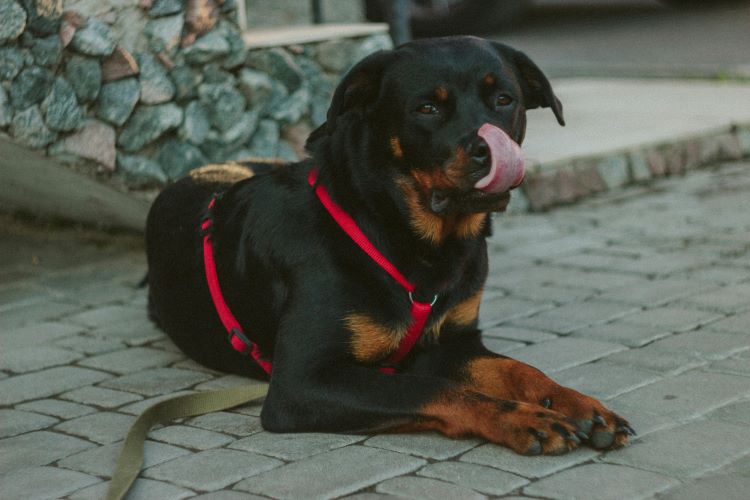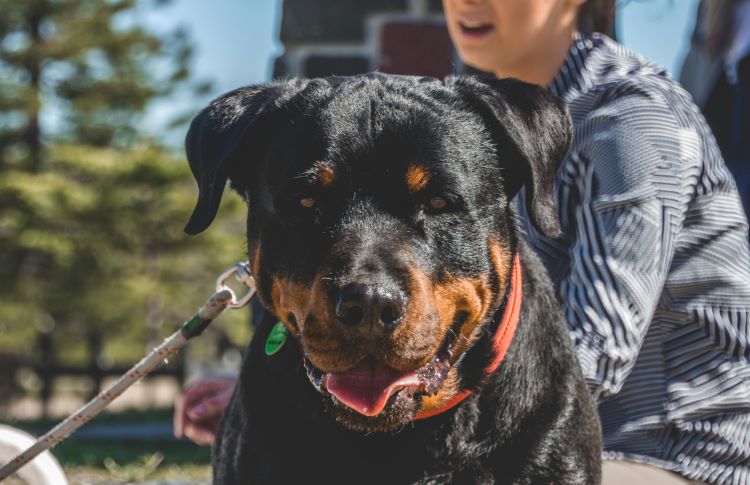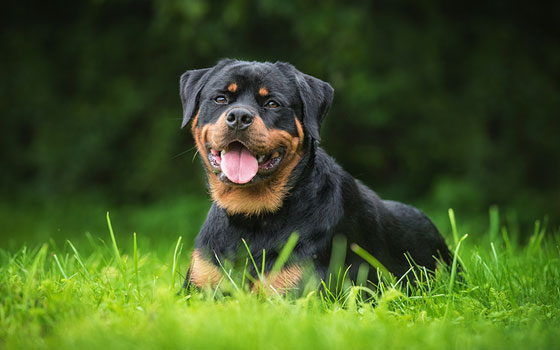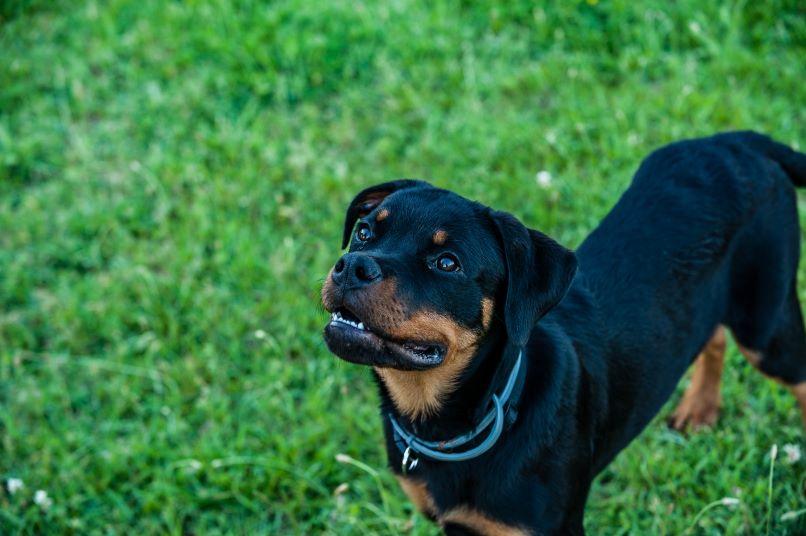Ready to help treat your pet to a healthy life?
Rottweiler Breed Guide: History, Temperament & Health
By : Trupanion Staff | Updated Sep 23, 2024

If you've never gotten to know a Rottweiler before, it's possible that you don't know the true nature of these strong, capable canines. They are subject to a lot of misconceptions, after all — some view the Rottweiler breed as dangerous due to its strength and history as a fighting dog, and some cities and countries even have laws banning it. But while "Rotties" tend to be highly protective of their humans, they also have a sweet, very affectionate side that has made them one of the most popular breeds in North America. Needless to say, they are both beloved and highly misunderstood.
So, is a Rottweiler the dog for you? Regardless of how you currently feel about the breed, it's important to separate fact from fiction. Whether you're interested in adopting one, want to learn more about your current Rottweiler's breed, or are just curious about these fascinating canines, this Rottweiler breed guide has you covered!
Why are they called 'Rottweilers?'
Rottweilers get their name from the German town of Rottweil, where the breed as we know it today was developed. That said, the breed’s origins are believed to actually date back to ancient Rome (scroll down for more on the breed's history further). After the Roman Empire collapsed, these dogs continued to thrive in the region of Rottweil, where they were essential in driving cattle to market and protecting livestock. Known as “Rottweiler Metzgerhund,” or “butcher’s dogs,” they helped butchers manage cattle and haul carts of meat. Over time, the breed became simply known as Rottweilers, retaining their reputation for strength, loyalty, and hard work.
Other fun facts about Rottweilers
- Rottweilers are a type of Molloser dog breed, which are among the oldest breeds in the world and are known for their strength and protective natures.
- You might hear this breed referred to as “Rotties” or “Rotts” by Rottweiler fanciers.
- Rottweilers were part of the search and rescue efforts at the World Trade Center site after the 9/11 attacks.
- The German town of Rottweil celebrates its link to the dog breed's origins with various statues and art displays through the streets.
- Rottweilers are known to have one of the strongest bite forces of all dog breeds, recorded at 328 pounds per square inch. That’s more than other famously strong breeds like the German Shepherd and the American Pitbull Terrier.
- The Rottie is born with a naturally long tail, which many US breeders dock shortly after birth. The practice is nevertheless illegal in Europe and other parts of the world.
- The undercoat of a Rottweiler is waterproof. Though they aren’t considered water dogs, many Rotts love to swim.
Physical description
The American Kennel Club (and other major kennel clubs around the world) only officially recognizes three types of Rottweiler in terms of color:
- Black and tan
- Black and mahogany
- Black and rust
Nevertheless, these dogs are sometimes seen with blue undertones and more vivid red in their coats. While there is variety in their markings, Rottweilers have some very distinctive physical features. These primarily include clear brown markings on the face (especially those expressive eyebrows), chest, and legs. Rotties are also described by their large, square-shaped heads and overall muscular builds.

In-depth history
The Rottweiler is a descendant of ancient Roman mastiff-type dogs, helping to guard and herd the livestock that accompanied the legions marching through Europe. In the 1st century AD, some of these dogs stayed behind, in an area along the Neckar River in Germany, which eventually became the town of Rottweil. The dogs became known as “the butchers’ dogs,” as they herded cattle and carted the butchered livestock to market. Butchers would also use Rotties as guard dogs, having them carry the bags of money collected from sales. A thief would think twice before trying to steal money from a Rottweiler!
The Rottweiler breed almost went extinct in the mid-1800s. This was the time of railroad proliferation, making the transport of livestock easier and lessening the need for drover and herding dogs. Luckily the breed was saved when people started training them to work as police dogs instead, a job in which they excel. Rottweilers were used extensively throughout both World Wars as military working dogs and gained popularity around the world.
North American history of the Rottweiler
The Rottweiler made its way to the United States in the early 1930s, with the American Kennel Club officially recognizing the breed in 1935. They ranked in the top five most popular breeds in the 1990s. It’s thought, the media stereotyping them as aggressive dogs knocked them out of the top five in the 2000s. They are currently the 8th most popular dog breed in the United States according to breed registrations. Rottweilers have served in many different working dog roles. They were one of the first breeds used as guide dogs for the blind and served in search-and-rescue roles for disasters such as the Oklahoma City Bombing and the World Trade Center collapse.

Are Rottweilers easy to train?
As sweet as they often are, a Rottweiler is not a dog breed for everyone. They are powerful, intelligent dogs that were bred to be protective, independent, and courageous. It’s up to the human to manage their Rottie’s environment and set them up for success. Training your Rottweiler should begin when they are a puppy and continue throughout their life.
Many people describe the breed as needing a firm hand or an owner who asserts dominance. This is 100% false! Punishment or force-based training is not needed. Once a Rottie understands what you want, they are eager to please. Their motivation to work for reward is much higher than any motivation to avoid punishment. Rottweilers need clear, consistent and positive leadership. For this reason, consider carefully if this is something you are prepared and equipped to provide.
Do Rottweilers get along with others?
Proper proactive exposure to new sights, sounds, people, dogs, and other animals as a young puppy is essential for a Rottweiler’s socialization. Maintain this positive socialization for adult Rottweilers with new people and places. They can be territorial and protective of their family, so it’s essential to maintain positive associations with strangers.
Rottweilers do well with children if they have been properly introduced and socialized as a puppy and beyond. They are known to form a deep bond with their family and act as guardians. Young children and dogs should always be supervised, and it’s helpful for a dog to have their own “safe space” where they can go when they need some quiet time.
Rottweilers can likewise enjoy living with other animals in the home if socialized from puppyhood. Take care when introducing your well-socialized adult Rottie to other dogs and animals, as their size and energy can be overwhelming.
Trainer tip
Pair meeting new people or animals with high-value training treats or a favorite toy, and keep introductions short and sweet so it doesn’t get overwhelming.
Exercise requirements
Daily exercise helps keep a Rottweiler entertained and at a healthy weight. Bred to work, they will excel as a family dog as long as they have an outlet for their exercise needs. Rotties do best with at least an hour of exercise every day. Once fully grown, they can make excellent jogging companions and hiking partners.
Speak with your veterinarian about appropriate exercise for a Rottweiler puppy. Until they are full-grown (bone growth plates typically all close by around 18 months of age), minimize excessive strenuous or repetitive activities like jogging or running — as this can increase the risk of damage to the growing bone and cartilage, causing pain and future joint issues (see more on Rottweiler health concerns further down).
Common behavioral issues
The Rottweiler breed is known to be incredibly smart and often described as “stubborn.” However, a Rottweiler is simply looking for their human to provide the “why” for performing a behavior.
They do best with a consistent and positive approach, as punishment-based training methods often result in fear, aggression, and increased stubbornness. Give them a good reason to do as you ask, with the right positive motivation and by building a strong bond, and they’ll be incredibly obedient and eager-to-please!
Mental enrichment is also essential for a Rottweiler, as they are an intelligent breed and love to solve problems. Feeding regular meals with puzzle-bowls, providing interactive toys, and keeping their brain engaged with regular positive reinforcement training will go a long way in preventing unwanted behaviors. Giving your Rottweiler puppy lots of enrichment will prevent boredom and provide them with an outlet for chewing and other normal puppy behaviors.
Activities for Rottweilers
Thanks to their energy, loyalty, and eagerness to perform, Rottweilers can excel in many different activities:
- Herding
- Cart pulling
- Rally obedience
- Schutzhund
- Therapy work
- Agility
- Search and rescue
- Dock diving
Health and care tips
Rottweilers, like many large dog breeds, are prone to certain health conditions due to their genetics, size, and breed-specific characteristics. While every dog is different, it's important to be aware of the types of health conditions your Rottweiler may be at higher risk for.
Regular vet check-ups, proper nutrition, and exercise can help prevent or manage many health conditions. Regular grooming is also a must to maintain your dog's everyday hygiene and well-being. For breed-specific concerns, it's also a good idea to ask your vet for recommendations on screenings or preventive measures. Protecting your Rottweiler with a good dog insurance plan while they're still young is also a wise decision.
Common health conditions in Rottweilers
- Hip and elbow dysplasia
- Osteosarcoma (a form of bone cancer)
- Aortic stenosis
- Entropion (rolled eyelid)
- Hypothyroidism
- Bloat (Gastric Dilatation-Volvulus)
- Allergies
- Cruciate ligament injuries
- Panosteitis (inflammation in growing bones)
- Cancer
- Progressive Retinal Atrophy (PRA)
- Obesity
Grooming
A Rottweiler has a thick double coat, with a shiny topcoat and waterproof undercoat. They have only one coat pattern, with black over most of the body and brown on the face (especially those expressive eyebrows), chest, and legs.
Rottweilers need a minimum of weekly brushing and occasional baths. While they do shed all year long, there is an increase in shedding twice a year, usually in the spring and fall, as their coat changes to prepare for warmer or colder weather.
Regular nail trimming is needed to keep nails at the proper length. Rottweilers have black nails, which can make it difficult to determine how much to clip without causing pain or bleeding. Nail grinding is a preferred trimming method for black nails.
Best Brush for a Rottweiler: Undercoat rake, pin brush

Rottweilers in pop culture
Thanks to their loving and loyal natures, Rottweilers are popular among many people across the world — including the famous! They've also appeared in numerous movies and TV shows.
Famous Owners of the Rottweiler
- Leonardo DiCaprio (Actor)
- Bruno Mars (Singer)
- Will Smith (Actor)
- Hayden Panettiere (Actress)
- Robbie Williams (Singer)
- David Backes (Hockey Player)
- Lonzo Ball (Basketball Player)
- LaMelo Ball (Basketball Player)
- Jahil Okafor (Basketball Player)
Rottweilers in art and media
- Black Beauty Breed is a documentary all about Rotties!
- Ferris Bueller’s family dog who attacks Mr. Rooney, in Ferris Bueller’s Day Off
- Uncle Eddie’s dog Snots in National Lampoon’s Christmas Vacation
- The unnamed “Hellhounds” from The Omen
